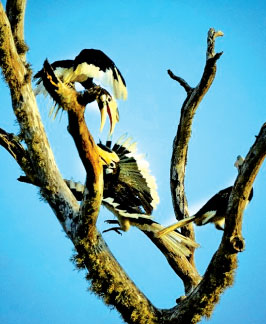
The Thrill of a Pied Hornbill
by Nilma Dole
Atop the fruit trees we hear a
calling like a `cawk’ and it’s always the Malabar Pied Hornbill (Anthracoceros
coronatus) who eats all the sweet cherry-like `Uguruassa’ from our tree.
Being from the family of hornbills, they are a tropical near-passerine
birds found in the Old World which love to roam in open and wet
broadleaved deciduous in lush evergreen forests mostly in the hill
country. The attractive birds make seasonal movements in response to
fruiting events, and sometimes visit isolated fruit trees in cultivated
areas.
 The Malabar Pied Hornbill is a common resident breeder in tropical
Southern Asia from India and Sri Lanka East to Borneo. Its habitat is
open woodland and cultivation, often close to habitation. During
incubation, the female lays two or three white eggs in a tree hole,
which is blocked off with a cement made of mud, droppings and fruit
pulp. There is only one narrow aperture, just big enough for the male to
transfer food to the mother and the chicks. The Malabar Pied Hornbill is a common resident breeder in tropical
Southern Asia from India and Sri Lanka East to Borneo. Its habitat is
open woodland and cultivation, often close to habitation. During
incubation, the female lays two or three white eggs in a tree hole,
which is blocked off with a cement made of mud, droppings and fruit
pulp. There is only one narrow aperture, just big enough for the male to
transfer food to the mother and the chicks.
When the chicks and the female outgrow the nest, the mother breaks
out and rebuilds the wall, then both parents feed the chicks.
The Malabar Pied Hornbill is a large hornbill, 65cm in length. It has
mainly black plumage apart from its white belly, throat patch, tail
sides and trailing edge to the wings. The bill is yellow with a large,
mainly black casque. Sexes are similar, but the immature have a smaller
casque.
This species is omnivorous, taking fruit, fish and small mammals.
Figs form an important part of their diet and contribute to 60 per cent
of their diet from May to February, the non-breeding season and during
breeding (March to April) up to 75 per cent of the fruits delivered at
the nest are figs. They also feed on other fruits including those of the
Strychnos nux-vomica that are known to be toxic to many vertebrates.
BirdLife International have declared them as a protected species in
2004 and they also have a place on the 2006 IUCN Red List of Threatened
Species.
The problem is that the forest in Sri Lanka has suffered rapid
degradation and fragmentation in the past decades through excessive
gathering of fuelwood, clearance for permanent agriculture, shifting
cultivation, fire, urbanisation and logging. Closed-canopy forest is
estimated to have declined from 29,000 km (44 per cent of the island’s
area) in 1956 to 12,260 km in 1983 and similar losses are occurring in
mainland India. It is reportedly collected for medicinal purposes in
Orissa.
Hence, this species has a moderately small population size, and is
likely to have declined as a result of continuing habitat loss. It is
therefore considered `Near Threatened’, and should be carefully
monitored for any future increases in the rate of decline.
Conservation measures proposed: Monitor populations across the range
to determine the magnitude of declines and rates of range contraction.
Investigate the potential threat from hunting. Grant protection to areas
of suitable habitat to safeguard against clearance and degradation.
Raise awareness of the species and its status in any areas in which it
is found to be hunted. |

